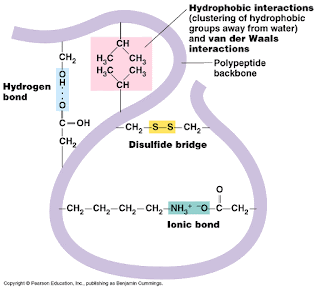Proteins are large, complex molecules that play many critical roles in the body. They do most of the work in cells and are required for the structure, function, and regulation of the body’s tissues and organs.
Proteins are made up of hundreds or thousands of smaller units called amino acids, which are attached to one another in long chains. There are 20 different types of amino acids that can be combined to make a protein. The sequence of amino acids determines each protein’s unique 3-dimensional structure and its specific function.
Protein Structure
| |
| |
Secondary Structure
| - Alpha Helices and Beta Pleated Sheets. - Held together by many hydrogen bonds, overall giving the shape great stability. |
Tertiary Structure
|
|
Quaternary Structure
|
Ø The structure formed when two or more polypeptide chains join together, sometimes with an inorganic component, to form a protein.
Ø The structure is maintained by hydrogen bonds, ionic bonds, hydrophobic interactions, and van der Waals interaction
|
References:
https://www.youtube.com/watch?v=hok2hyED9go
https://alevelnotes.com/notes/biology/biological-molecules/biological-molecules/protein-structure
https://alevelnotes.com/notes/biology/biological-molecules/biological-molecules/protein-structure
https://www.dreamstime.com/levels-protein-structure-amino-acids-to-complex-molecule-polymer%C2%A0polypeptide-formed-sequences-primary-secondary-image150715433




No comments:
Post a Comment